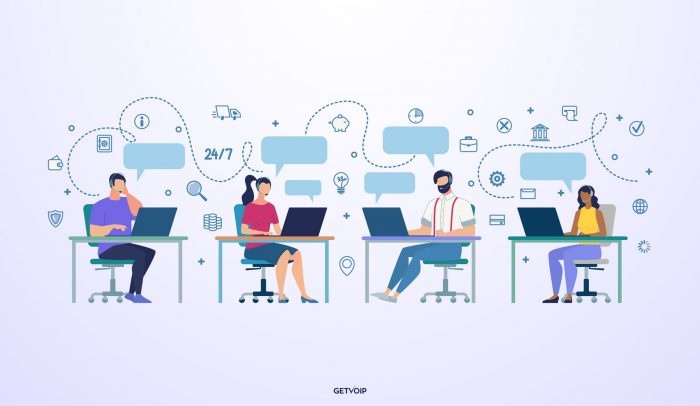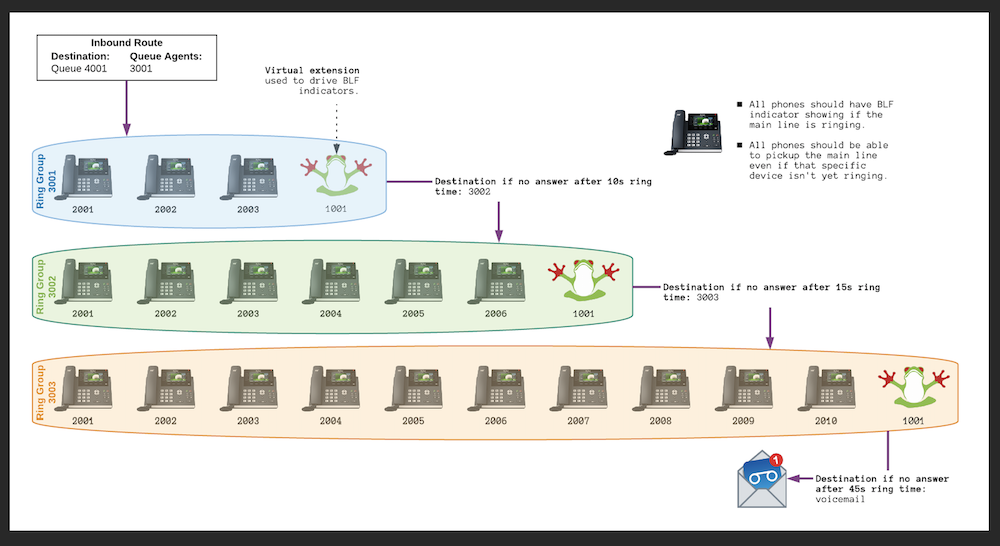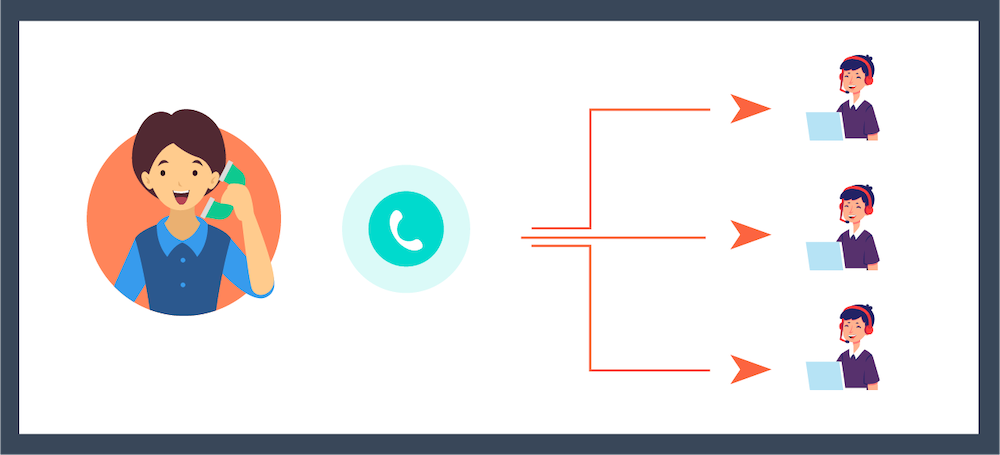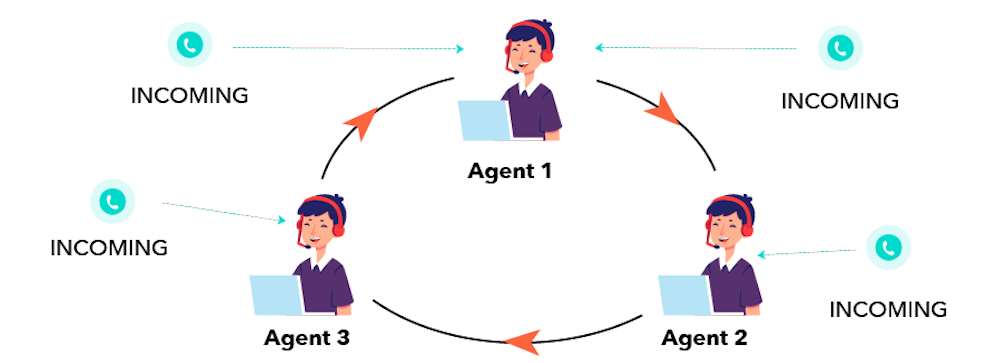From the customer chat windows that automatically pop up on eCommerce websites to the SMS messages offering real-time shipping notifications, it’s clear that today’s customer service revolves around instant gratification.
In a world where over 90% of customers expect a response from a company representative in ten minutes or less, fast and knowledgeable support is no longer an exception -- it’s a rule.
Website chat, automated email reminders, and social media direct messaging have digitized the ultra-fast customer experience.
But how can you increase the speed of your phone support responses and resolutions without sacrificing quality?
By utilizing the call group function.
What is a call group, what additional benefits will they offer your company, and which providers have this feature?
- Call Group Overview
- Benefits
- Call Group Ring Patterns
- How To Create A Call Group
- Top Call Group Providers
- Improve Phone Support
- FAQs
What Is A Call Group?
A call group (also called a ring group) is a call handling strategy that directs inbound calls to a predetermined “group” of phone numbers and extensions.
Therefore, as opposed to directing incoming calls to just one phone number, several agents within one call group will have the opportunity to answer an inbound call.
Admins can set call groups to ring all these numbers simultaneously, or select from a variety of ring patterns -- more on that later in this post.
This means callers will be more likely to reach a live agent, and that they won’t need to call back several times or, in many cases, even leave a message to do so. (If no member of the group is available, the caller can then opt to leave a voice message or simply remain on hold.)
Call groups work best when used within a department or team where all of the employees have roughly the same skill sets, qualifications, and product/service knowledge. Equally informed agents avoid major customer service problems and reduce the number of callbacks.
For example, let’s say your client Sue calls the billing department. Your billing team is made up of four employees, and all of them know how to accept payments, solve common billing problems, change billing addresses, and other essential information.
Sue will be equally served by anyone in your billing department, no matter which agent takes the call. Your goal is to get Sue’s billing problem solved -- preferably on the first call.
So, to increase the chance of first call resolution, all five of your billing agent’s phones ring at once. Agent Oscar is on the phone, Agent Joe is away from his desk, Agent Jess is out sick, and Agent Andrea is available. Therefore, Andrea will pick up the phone and assist Sue, and Sue will avoid having to be transferred from agent to agent or having to wait on hold for Joe to get back to his desk.
Call Groups vs. Call Hunting
Though both call groups and call hunting share the goal of making it more likely for a caller to reach a representative, there are differences between the two.
Call hunting, also called Find Me/Follow Me, is when an inbound call directed for a particular agent is forwarded to multiple numbers on which that agent can be reached. For example, if the agent doesn’t answer her office phone, the inbound call will be automatically forwarded to her cellphone, then her home phone, and then finally her voice mailbox.
Call groups, on the other hand, will automatically forward inbound calls to one or all agents within that group. Often, call groups are made up of a group of agents that can all be reached via the same number, which directs the caller to a particular department. (For example, your business might have one number or extension for customer service queries and an entirely different number for sales.)
Call hunting is ideal when only one agent truly has the knowledge to assist the caller, whereas call groups work for a group of agents, all of which have the ability to help the customer with their issue.
What Are The Benefits Of Using Call Groups?
Call groups help to lower your call abandonment rate, speed up the support process, and improve call management in several ways.
How can they help your business to cut down on hold times and decrease employee turnover?
Read on to find out.
Decreased Call Wait Times
In a perfect world, customers would have no problem waiting on hold until a representative becomes available.
In reality?
Given that few customers say they’re willing to stay on hold until they’re connected with a representative, a failure to connect a caller with an agent within a minute will most likely result in a hang up.
And if you think those customers are likely to call back another time, think again.
Ring groups seriously decrease caller wait time, improving the overall customer experience and speeding up the resolution process. Shorter wait times optimize your agents, make your customers happy, and lower your call center technology and operating costs all at the same time.
Improved Call Distribution
Like popular call routing strategies, call groups optimize your workforce by evenly distributing the workload, preventing employee burnout and frustration.
Given that call centers have an especially high turnover rate, (between 30-45%) anything you can do to make your agents happier will save you the costs and time associated with having to train new employees.
Plus, especially if your inbound calls are sales-related, ring groups give all of your agents an equal chance at being connected to a high-quality prospect.
However, improved call distribution doesn’t just benefit your team members.
Because callers will reach an agent that is guaranteed to have the qualifications needed to help them with their issue, they’ll have a better impression of your overall customer support and company as a whole.
Given that over 60% of consumers say that reaching a qualified, knowledgeable agent is one of the biggest determining factors in whether or not they have a positive customer service experience, call groups will go a long way when it comes to impressing your customers.
Increased First Call Resolution Rates
Since call groups mean that callers are more likely to connect to a qualified live agent every time they contact your company, you’re likely to see higher increased first call resolution rates.
A high rate of FCR is essential to a streamlined contact center and happier customers.
Remember, every time a customer has to call back, they run the risk of having to repeat their problem to yet another agent unfamiliar with their issues -- something that’s certain to wreak havoc on customer satisfaction rates.
Even just a 15% increase in FCR decreases repeat calls by nearly 60%.
Fewer repeat calls mean that your agents will be freed up to attend to more time-sensitive customer service issues, available for more sales calls, and will be able to spend more time developing a personal relationship with clients.
Better Call Management For Higher Call Volumes
Whether your business has a constantly high call volume, or if your phones seem to be ringing off the hook during your three-month busy season, being unprepared for a sudden influx of calls is one of the most disastrous business communication issues.
If your call volume has increased by 10% above its normal rate, it’s time to consider ways to improve your call management strategy.
Call groups mean that more agents will be available to answer client calls, but that you won’t have to go through the expense of hiring new agents to meet customer demand.
Call Group Ring Patterns
As with standard call routing, there are several ring patterns to choose from when setting up your ring group.
The top three patterns are:
Sequential Ringing
Sequential ringing is ideal for smaller businesses that have a primary agent/contact for one department or customer issue, but may need backup if that agent is unavailable to take an inbound call.
Here, all agents and any connected devices/numbers will ring one at a time in a predetermined order.
For example, the office secretary usually takes inbound calls and directs them to the right agent. However, they’re away from their desk. The call may then be sent to their smartphone, and if they don’t answer that, the call is sent to an additional designated agent.
Simultaneous Ringing
The simultaneous ring option is ideal for larger call centers that prioritize first call resolution rates and low wait times.
Here, an inbound call is sent to all the members of a ring group at the same time. The first agent to pick up handles the call.
Cyclic Ringing
Often referred to as rollover ringing, a cyclic ring pattern is ideal for businesses that need to ensure an equal distribution of inbound sales/support calls.
An inbound call is first sent to Agent 1. If Agent 1 does not answer, the call is sent to Agent 2 after a set number of rings. If Agent 2 answers, the next inbound call will go to Agent 3. The cycle then repeats, taking turns in a round-robin style.
How To Create A Call Group
Though individual providers will have specific instructions on how to create ring groups, the basic concept is still the same.
While call groups only require at least two agents to create, having at least three agents per group is ideal. There are numerous ways to decide which agents belong in which group. For example, admins can create call groups according to skill set, department, alphabetically (if all agents have the same training), or according to productivity/sales levels.
Each group should have a name, location and time zone information, caller ID, and a set call distribution policy/ring pattern.
Ring groups can be reached by dialing a direct phone number or extension, or be reached based on the options the caller selected in the IVR call menu. (For example, if the customer presses “1” to be connected to the sales department, the customer’s call will be forwarded to the sales ring group.)
Admins can also choose how many rings or seconds on hold the caller will need to wait through before their call is forwarded to another member of the ring group. They can also outline a call path for unanswered calls if, for example, all agents are busy or unavailable if the call comes in after business hours.
Note that admins can add additional extensions/phone numbers to existing ring groups, reassign agents to new groups, and remove agents from existing ones.
Some software providers allow users to create an unlimited number of ring groups, while others have a set maximum per plan with the option to add on more groups for an additional fee.
Top Call Group Providers
Now that you understand the basics and benefits of call groups, let’s move to exploring the top providers.
Here, we’ll fill you in on the top business phone solutions that offer call groups, as well as which plan(s) the feature is available with.
Nextiva
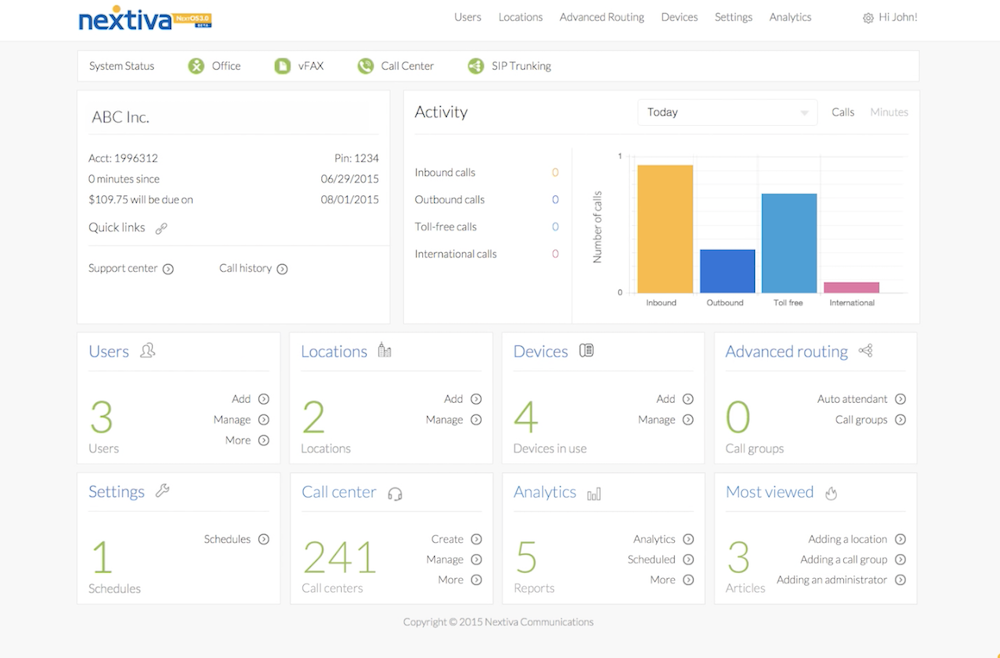
Nextiva is a business VoIP and contact center solution offering ring group capabilities.
Available ring patterns include cyclical, linear, simultaneous, sequential, most idle, and weighted.
Admins can specify each group’s time zone and location, the caller ID that shows on a customer’s phone, the direct number to be dialed to reach the group, and which department the call group is within.
Advanced settings include whether or not to allow call waiting, to allow agents to enable or disable call forwarding, and setting the amount of time or number of rings after which calls will be sent to other agents within the ring group.
Nextiva also offers a call group voicemail that all agents within the group can access and respond to.
In addition to adding standard business phone numbers to a ring group, admins can also add alternate numbers like smartphones or home phones. Admins can then assign different ring patterns (called a “distinctive ring”) to each alternate number or alternate extension for even more specific call routes.
Admins can also access call analytics like the number of inbound, outbound, toll-free, and international daily calls, average call handling time, call duration, call abandonment rate, and more.
Nextiva offers the call group feature on all four of its main plans, which range in price from $17.95/user per month to $52.95/user per month.
Our detailed Nextiva review offers additional information on available pricing and plans.
Best For: Nextiva is best for large-scale, enterprise-level companies with multiple locations in numerous time zones. Companies with a high daily call volume and need not only advanced ring group capabilities, but also other advanced call center features like CRM integration, voicemail transcription, and video calling, and screen sharing.
Vonage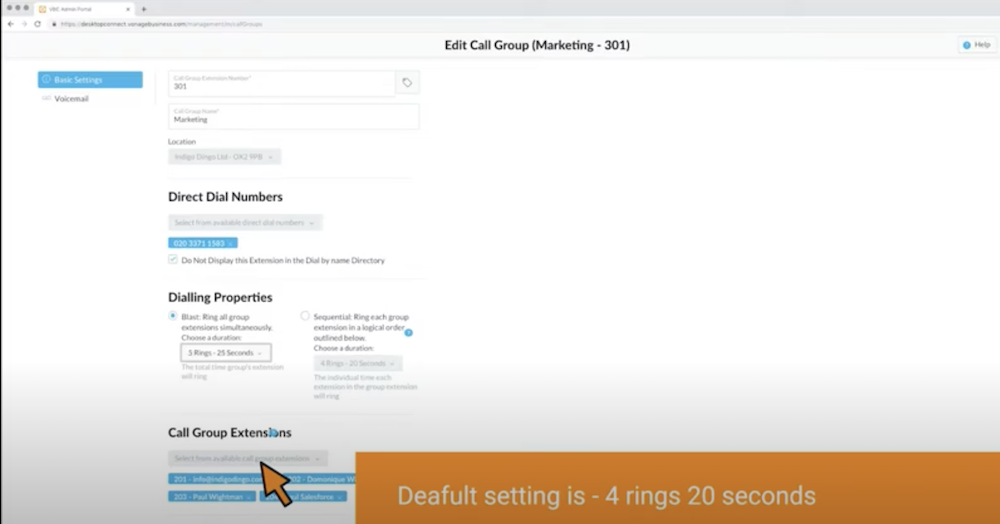
The Vonage business communications platform is an omnichannel communications system with VoIP phone functionality.
Its call group feature allows admins to identify groups by name, location, extension/direct dial number, and custom tag.
Vonage offers two types of call groups: call blasting (simultaneous ringing for all group agents) and sequential. Ring durations that manage how long customers wait before their call is transferred can be set according to seconds or number of rings.
Call group extension orders can be easily configured via the drag-and-drop interface.
One of the most unique features is the name greeting tool, which allows admins to select a pre-recorded message that will play to identify extensions to callers. Admins can also set call screening with a screening menu that allows agents to accept, reject, or forward inbound calls. The Call Announce feature lets agents hear any previously recorded call category tags, such as “This is a call for sales.”
Like Nextiva, Vonage also offers call group voicemail and extension-specific voicemail.
Voicemails can also be sent to email via text or MP3 recordings.
Vonage’s Advanced Plan for $39.99/user per month is the only plan that includes call group capabilities. However, users of the $19.99/user per month Mobile plan and the $29.98/user per month can purchase Call Groups as an add-on feature costing $4.99/month.
Learn more about Vonage in our complete review of Vonage business solutions.
Best For: Vonage is best for medium to large-sized companies that prioritize ease-of-use. Companies that often have calls that go to voicemail, even when ring groups are enabled, will also benefit from Vonage. It’s also primarily best for businesses that don’t need advanced ring pattern options.
RingCentral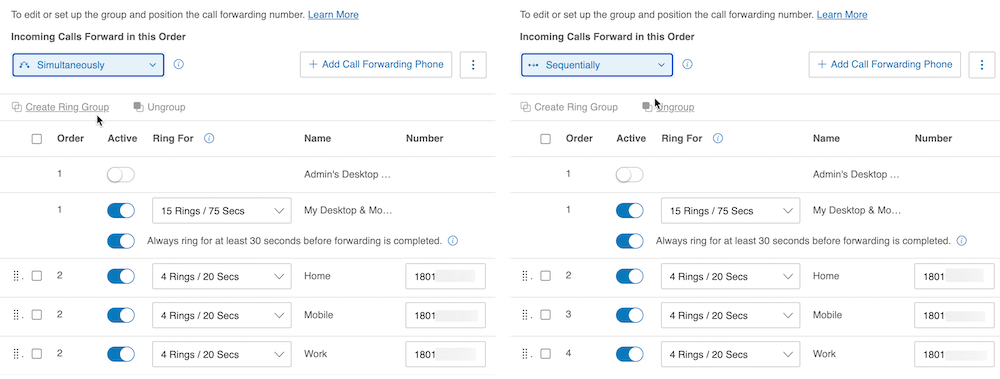
RingCentral offers a VoIP business cloud phone system as a part of its RingCentral RingEX suite integrating phone, messaging, and video communications.
RingCentral’s ring groups offer sequential and simultaneous ringing across multiple devices, including Android and iPhone iOS smartphones. It also allows admins to set answering rules according to the caller’s phone number and the date or time. This means it’s easy to adjust call groups for busy times of the year, when agents are on vacation, or during business holidays.
Admins can direct calls to move through the standard ring group answering rules, or proceed directly to the voice mailbox or a pre-recorded message.
Up to 16 different agents/extensions can be in one ring group.
RingCentral also offers a ring group paging feature, which makes delivering internal messages to team members assigned to a specific group simple.
Custom hold music, group voicemail, call parking, and group status updates are also available. Users can change the number of rings or the number of seconds before a call is forwarded to an additional agent and reorder the current call forwarding path within ring groups at any time.
Ring groups are available only with the Standard, ($24.99/user per month) Premium ($34.99/user per month) and Ultimate ($59.99/user per month) plans. Groups are not available on the Essentials RingEX plan.
Our RingCentral review provides more details on available plans, pricing, and features.
Best For: RingCentral is best for medium to large-scale companies that need advanced and highly customizable ring group configuration options, but who also use other communication channels often to connect with customers. Phone systems may or may not be the primary mode of communication for RingCentral users, but those that still want robust phone features when they do make or receive phone calls will reap the benefits of RingCentral Office.
8x8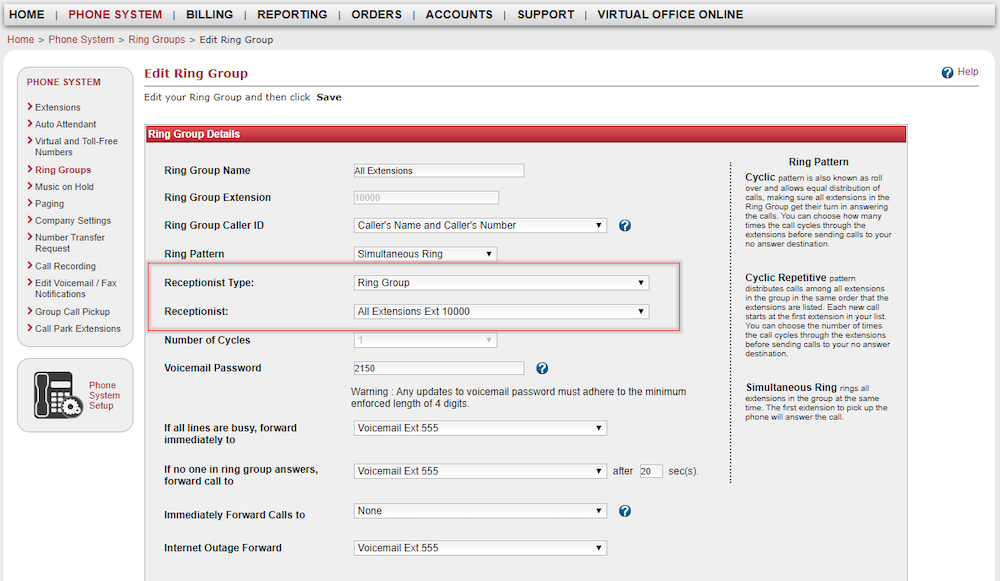
8x8’s Business Phone Service is a cloud PBX business calling tool complete with ring groups.
Available ring patterns include simultaneous, cyclic, and linear ringing.
In the admin portal, users can set the ring pattern, the number of cycles per pattern, where calls should be forwarded in the event of a busy signal or no answer, and which voice mailbox missed calls are sent to. Note that calls can easily be forwarded to external numbers of ring group members with 8x8.
Admins can set ring groups to forward calls to multiple numbers per agent, or simply send the call to the next agent on the list.
Ring group caller ID’s can include the ring group’s name and extension, the caller’s phone number and the ring group name, or only the caller’s information.
While 8x8 offers group call voicemail, admins can restrict which agents have access to the voice mailbox. Each ring group has its own individual, password-protected, voice mailbox.
Users can configure up to 9 ring groups, and purchase additional groups in sets of 1, 6, or 15. In addition to ring groups, 8x8 also offers call parking, call waiting, and a multi-level auto attendant. Hold music and pre-recorded gretings are also available.
Ring Groups are available on the 8x8 X Series contact center plans, starting with the X2 plan from $24.00/user per month.
Check out our complete 8x8 review to learn more.
Best For: 8x8 is the right fit for companies of any size seeking scalable business phone and omnichannel contact center solutions. It’s business phone system is specifically designed to increase first call resolution rates, and offers competitive unlimited global calling in 47 countries, meaning it’s a good option for international businesses. It’s HIPAA-compliant, meaning it’s also ideal for those in the healthcare field.
Other Ways To Improve Phone Support
Now that you understand how ring groups can improve your call management strategy, it’s time to consider which other VoIP telephony features can further streamline business communications.
IVR systems, call forwarding and call transfers, omnichannel communication with real-time syncing, and automated call distribution (ACD) all help to connect your customers with the most qualified agents as quickly as possible.
Curious to learn more about the most important business phone systems features and discover even more ways to lower operating costs and increase agent efficiency?
Call Group FAQs
Below, we’ve compiled a list of the most common call group FAQs.

